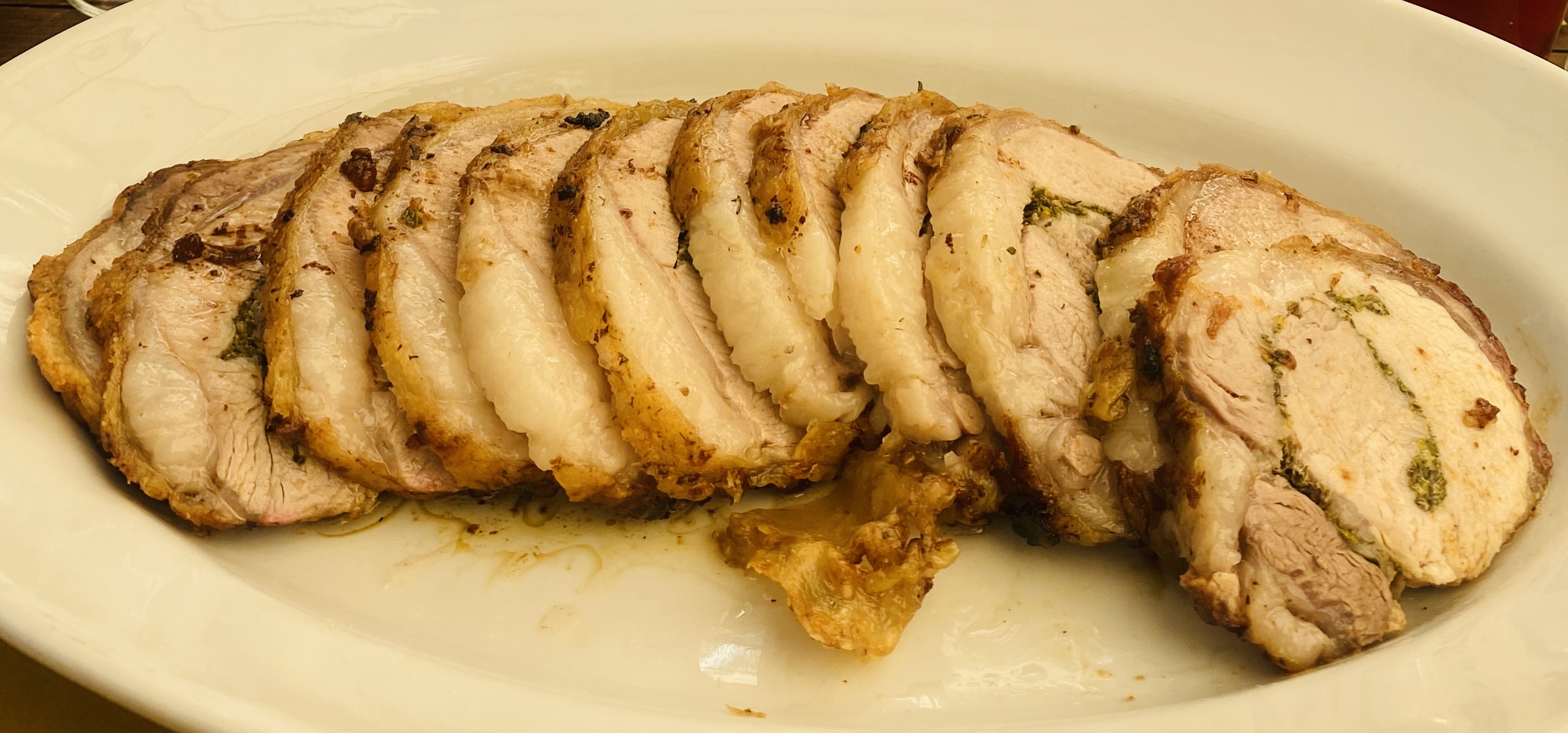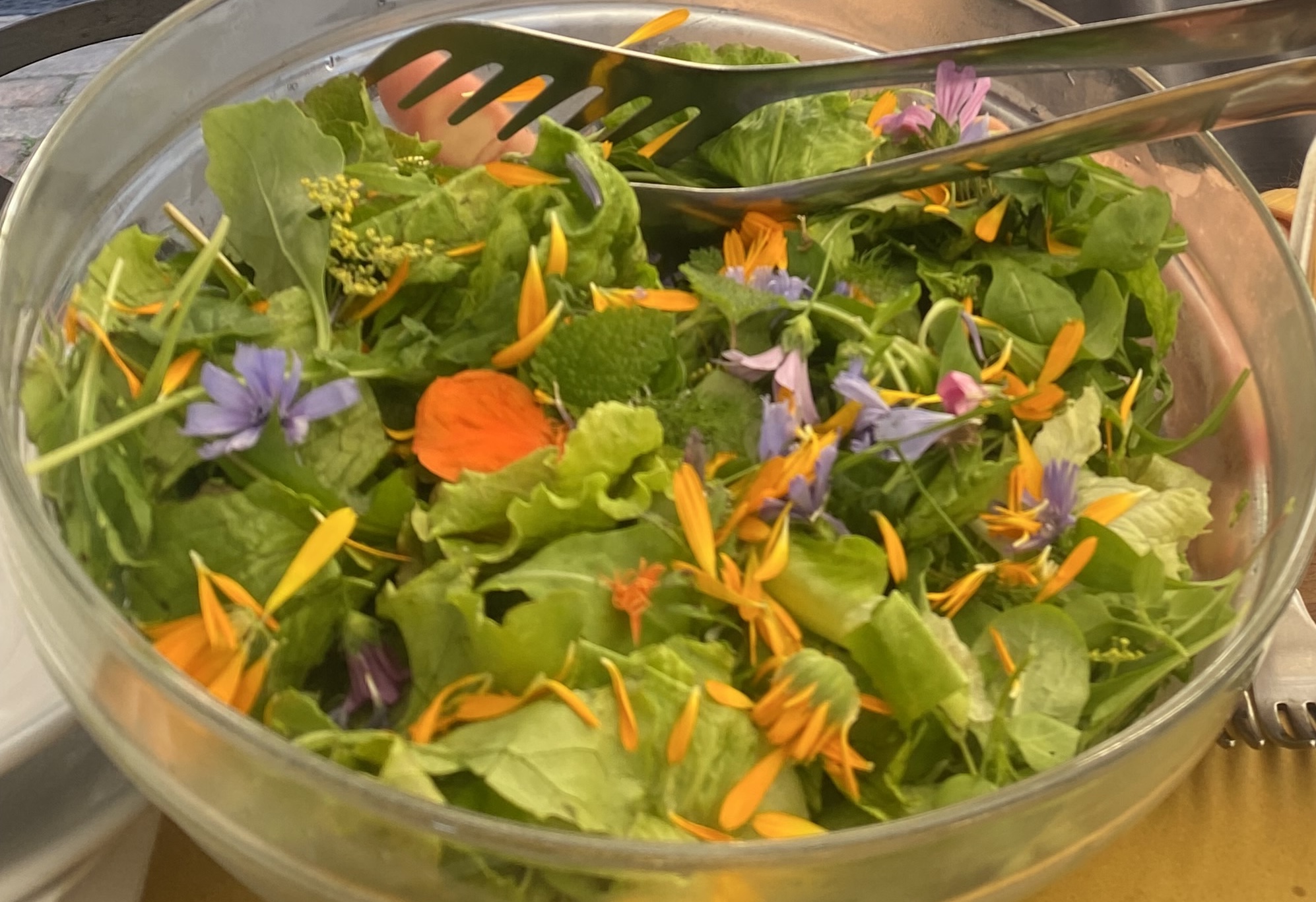The Darina Allen Column - Sustainable Farming in Tuscany
Ever hungry to increase her extensive knowledge on the best ways to farm and eat healthily in harmony with nature - especially in view of the new Ballymaloe Organic Farming School that she is establishing to build on the Sustainable Food Production Courses initiated at Ballymaloe Cookery School before Covid – Darina has been travelling far and wide to learn more about sustainable farming systems and biodiversity. This month she shares some fascinating insights from a visit to Tuscany in the autumn – inspiration for us all to do more for the environment and to eat better food as we head into a new year.
Trundling along on the train from Pisa to Siena in October, it was a joy to see so many lovely little vegetable gardens alongside the railway track. Lots of globe artichokes plants, beans still clambering up wicker teepees, end of season sweetcorn and tomatoes, a few grape vines and here and there a couple of olive trees. The weather was beautiful, clear blue skies, the countryside was bathed in sunshine, nonetheless everything looked sad and parched.
I was on my way to Tenuta di Spannocchia, a 2,000 acre organic estate in the midst of Maremma national reserve in the province of Siena, to attend a Climate Farm School.
My fellow participants were all from the US, many were involved in policy making for large corporations who are anxious to have a sustainable green image. Others are advising philanthropists and private clients interested in investing in regenerative projects. All were there to learn and understand more about farming systems, how ethically nutrient dense food is produced and how we can best farm in harmony with nature to enhance the fertility of the soil, sequester carbon and produce healthy plants, animals and humans and absorb rainfall.
Except there was no water...It's been months since there's been a drop of rain, consequently, there were no olives and it's a terrible year for viticulture. At a rough guess, they will have about a quarter of the usual grape harvest.
Apparently, it was insanely hot throughout the summer and was still around 30°C in mid-October. Many forest fires also, but fortunately not on the Spannocchia estate where there are hundreds of acres of forest.
During the week, many brilliant speakers spoke on a variety of related topics, the soil, geology, permaculture, forest and woodland management, models of transformation, a climate action plan...
We visited another eco estate, Tenuta di Paganico, who rear longhorn cattle and Cinta Senese pigs and have a farm shop and café where visitors can buy the beef and heritage pork and taste the produce of the estate and local area.
We also visited an organic rice farm at Tenuta San Carlo in the heart of Maremma in southern Tuscany owned and managed by Ariana, the fourth generation to steward this estate with a deep commitment "to create a better future for our children, our community and our planet".
Everywhere we heard of the myriad of challenges facing farmers in every area at present, not least the fear and uncertainty caused by the unpredictability of climate change, coupled with the poor price for their produce at farm gate.
Early one morning at Spannocchia, Danielle took us foraging in the herb garden to collect some weeds, herbs and wild plants to incorporate into our cooking class. I am intrigued by food in the wild and always eager to learn more.
Some plants were familiar to me, many others were an exciting new discovery.
We picked the leaves of sow thistle (Sonchus oleraceus) and common poppy to add to the spinach and Swiss chard to incorporate into the filling for homemade ravioli. Apparently, pigs love sow thistle hence the name. They have yellow flowers and look a bit like tall dandelions. The red poppy flower petals went into the salad. I love the honey/pea flavour of the young bladder campion leaves (silene vulgaris) They too went into the salad, together with the narrow, pointed leaves and white flowers of stitchwort (Stellaria holostea), also called the star of Bethlehem.
I also discovered that the shoots and roots of Hawksbeard (Crepis) are also edible and very good in the salad.
It's also worth remembering that what we call weeds today, were our ancestors' medicine cabinet and many contribute a myriad of health benefits. Wild plants haven't been tampered with to increase yield, so still have the full complement of vitamins, minerals, trace elements and bioactive compounds like polyphenols not easily found in today's processed foods.
We've crystallised violet flowers for years, but I hadn't realised that the leaves are also edible and delicious. So, they too can go into a green salad from now on.
Back into the kitchen, where Laura and Daniella gave us a cooking class. We all made pasta together, chopped fresh herbs, stuffed ravioli and watched as Laura butterflied a loin of pork and slathered it with freshly chopped rosemary, sage, and lots of fennel leaves, flowers and seeds.
We made a delicious fig leaf panna cotta for dessert and a wonderfully diverse Foragers salad to accompany the roast pork.
Here are some of those recipes, which I hope you'll enjoy making at home.
FENNEL PESTO (Pesto Al Finocchietto Selvatico)
Loved this Spannocchia riff on pesto.
Serve with pasta or on crostini. It should be a thicker consistency for crostini.
Makes 2 x 200ml jars
Parmesan cheese, freshly grated, (gritty)
almonds or cashew nuts
2 large cloves of garlic
110g wild fennel
salt and freshly ground black pepper
175-225ml extra virgin olive oil
Using a food processor, blend together the cheese, nuts and garlic. With the blade running, add the wild fennel, salt and freshly ground black pepper. Combine well, drizzle in the oil slowly (with the blade still running) as the pesto comes together.
 PORK LOIN WITH SAGE, ROSEMARY AND FENNEL (Arista al Finocchietto)
PORK LOIN WITH SAGE, ROSEMARY AND FENNEL (Arista al Finocchietto)
At Spannocchia they included fennel in this recipe at three stages – leaves, flowers and seeds. The arista pork is also very tasty served the following day at room temperature, with homemade aioli or fennel mayonnaise. Serves 6
1kg pork loin or neck/cappacuolo
5-6 sage leaves
1 sprig rosemary
fennel leaves and flowers if available
flaky sea salt and freshly ground black pepper
fennel seeds
4 tbsp extra virgin olive oil
Preheat the oven to 220°C/Gas Mark 7.
Finely chop the sage leaves, rosemary, fennel leaves and flowers together.
Butterfly the pork with a sharp knife to open it out to twice the length.
Season the pork loin with flaky sea salt and freshly ground black pepper; sprinkle the chopped herbs and the fennel seeds evenly over the pork. Roll up and tie firmly. Then drizzle well with extra virgin olive oil.
Place the loin roll on a baking tray and pop into the preheated oven for 20 minutes, reduce the heat to 180°C/Gas Mark 4 and continue to cook for 55 minutes approx. until the internal temperature reaches 72°C.
When the pork is cooked, remove from the oven and allow it to rest. Skim the juices from the tray and spoon over the pork.
When ready to serve, remove the pork from the tray and slice (not too thinly!). Garnish with sprigs of rosemary and fennel.
 A SALAD OF FORAGED GREENS AND FLOWERS
A SALAD OF FORAGED GREENS AND FLOWERS
For the mixed salad, the following plants work well together:
stitchwort, pennywort, lemon balm, wild fennel, salad burnet, bittercress, common sorrel, purslane, plantain, nepeta, cowslip leaves and flowers, evergreen clematis (Clematis vitalba), nasturtium leaves and flowers, chive flowers, chicory leaves and flowers, leaves and flowers of purple mallow, violet leaves and flowers, marigold and daisy petals, wild thyme leaves, dandelion leaves and petals, bladder campion leaves and flowers, sage flowers, rosemary flowers, borage flowers, zucchini blossoms, rose petals, common poppy leaves and flowers.... Plants used for the salad should be young and fresh.
ITALIAN DRESSING
Note: Italian lemons are much sweeter and juicier than the imported fruit we have access to so, if using lemon juice, it may be necessary to add sugar to the dressing.
1 tbsp fresh lemon juice or Balsamic vinegar
3 tbsp extra virgin Tuscan olive oil
sea salt and freshly cracked pepper
sugar to taste, use only with lemon juice
Wash and dry the salad leaves, combine the ingredients for the dressing. Just before serving, toss the salad with the dressing and serve immediately.
.jpg) FIG LEAF PANNA COTTA
FIG LEAF PANNA COTTA
Serve with candied figs or a compote of fruit. Serves 8-10
1 litre light cream (half milk/half cream)
4 tbsp sugar
5-6 fresh fig leaves, grilled over a gas flame for 1-2 minutes
3 sheets of gelatine
1 egg yolk
4 tbsp of milk
Put the cream, sugar and fig leaves into a saucepan over a low heat, stirring often until the liquid comes almost to boiling point. Remove from the heat.
Put the sheets of gelatine into a bowl and cover with cold water. Allow to sit for a few minutes to soften.
Remove the gelatine sheets from the water (discard the water). Squeeze out the excess water. Add the softened gelatine sheets to the fig flavoured cream and sugar, stir for a few minutes until dissolved.
In a separate bowl, whisk the egg with the milk. Whisk in the fig flavoured cream and sugar mixture. Stir very well.
Pour the mixture into individual bowls and leave to cool in the fridge for at least 3-4 hours or until set.
Serve on fresh fig leaves with candied figs.
HOT TIPS
Traditional Ducks and Geese
I'm forever on the lookout for exciting and authentic artisan producers...I was overjoyed to recently meet Tony and Mary Walsh from Kilkenny Free Range who rear free range geese and Aylesbury ducks on their farm in Shellumsrath, Co. Kilkenny. It's becoming increasingly difficult to source traditionally reared poultry and ever more important to support and spread the word when you find a really good product. For more information, see www.kilkennyfreerange.com
Two exciting new food spots to add to your Cork list...
Proby's Kitchen, close to the historic St Finbarr's Cathedral in the medieval part of Cork city is causing quite a stir. Breakfast from 8am and lunch till 3pm. At the weekends, there's a yummy brunch also cooked from scratch with fresh, seasonal produce, check it out... For more information, see @probyskitchen on Instagram
Also worth a detour is Church Lane in Midleton, already rocking with live music on Friday, Saturday and Sunday evening. A newly opened gastro bar just off the Main Street, open daily from 10am serving freshly made scones and coffee. Lunch is served from 12-4pm and dinner from 5.30pm – 9pm Thursday to Saturday. Another great way to have a new adventure and support lovely Midleton as it valiantly recovers from recent catastrophic flooding. For more information, see @churchlanemidleton on Instagram





There are currently no comments
Leave a comment
Not a member? Register for your free membership now!
Or leave a comment by logging in with: